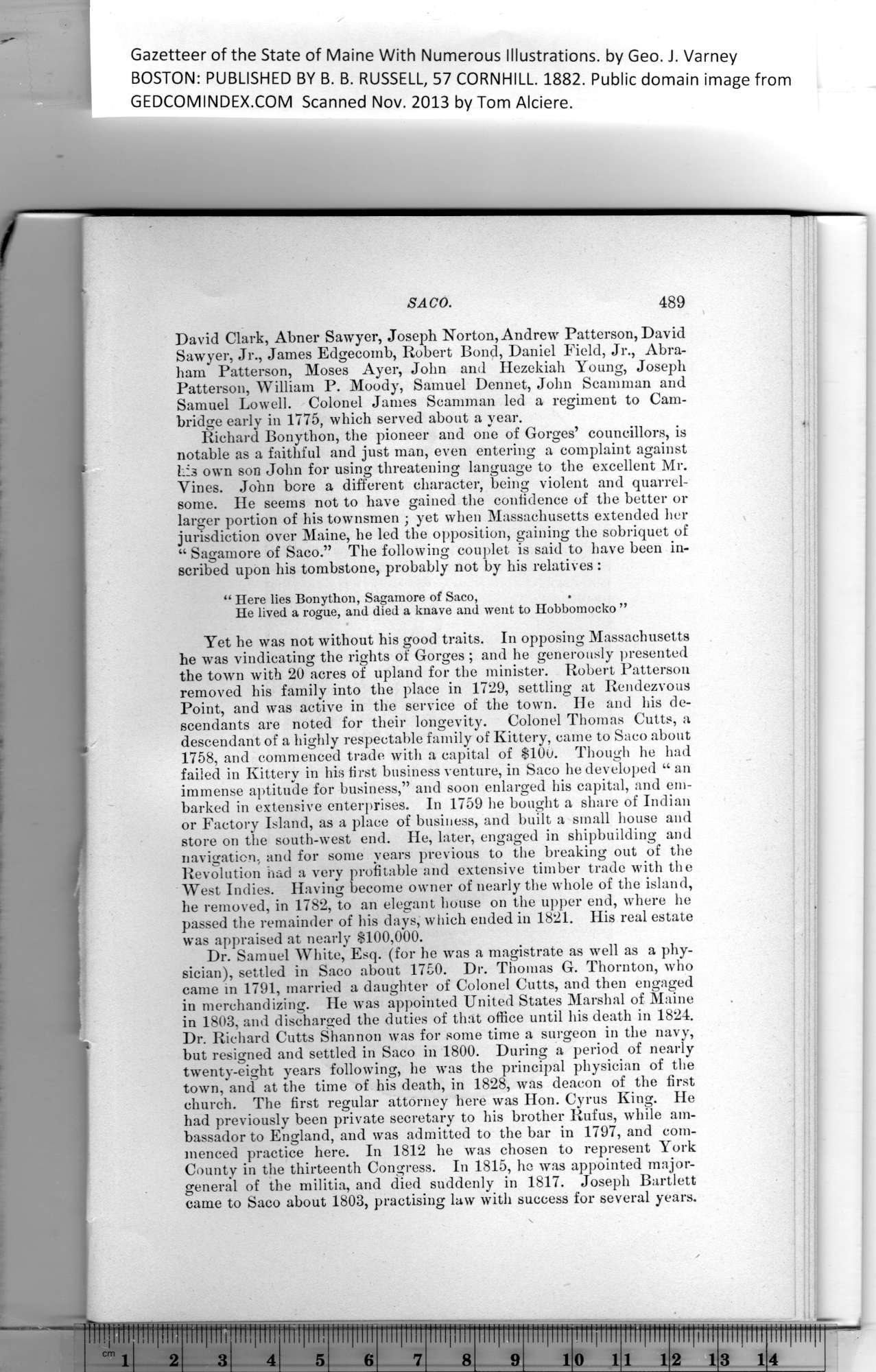|
Gazetteer of the State of Maine With Numerous Illustrations, by Geo. J. Varney
BOSTON. PUBLISHED BY B. B. RUSSELL, 57 CORNHILL. 1882. Public domain image from
SACO.
David Clark, Abner Sawyer, Joseph Norton, Andrew Patterson, David
Sawyer, Jr., James Edgecomb, Robert Bond, Daniel Field, Jr., Abra-
ham Patterson, Moses Ayer, John and Hezekiah Young, Joseph
Patterson, William P. Moody, Samuel Dennet, John Scamman and
Samuel Lowell. Colonel James Scamman led a regiment to Cam-
bridge early in 1775, which served about a year.
Richard Bonython, the pioneer and one of Gorges’ councillors, is
notable as a faithful and just man, even entering a complaint against
his own son John for using threatening language to the excellent Mr.
Vines. John bore a different character, being violent and quarrel-
some. He seems not to have gained the confidence of the better or
larger portion of his townsmen ; yet when Massachusetts extended her
jurisdiction over Maine, he led the opposition, gaining the sobriquet of
“ Sagamore of Saco.” The following couplet is said to have been in-
scribed upon his tombstone, probably not by his relatives :
“ Here lies Bonython, Sagamore of Saco, •
He lived a rogue, and died a knave and went to Ilobbomocko ”
Yet he was not without his good traits. In opposing Massachusetts
he was vindicating the rights of Gorges ; and he generously presented
the town with 20 acres of upland for tbe minister. Robert Patterson
removed his family into the place in 1729, settling at Rendezvous
Point, and was active in the service of the town. He and his de-
scendants are noted for their longevity. Colonel Thomas Cutts, a
descendant of a highly respectable family of Kittery, came to Saco about
1758, and commenced trade with a capital of $100. Though he had
failed in Kittery in his first business venture, in Saco he developed “an
immense aptitude for business,” and soon enlarged his capital, and em-
barked in extensive enterprises. In 1759 he bought a share of Indian
or Factory Island, as a place of business, and built a small house and
store on the south-west end. He, later, engaged in shipbuilding and
navigation, and for some years previous to the breaking out of the
Revolution had a very profitable and extensive timber trade with the
West Indies. Having become owner of nearly the whole of the island,
he removed, in 1782, to an elegant house on the upper end, where he
passed the remainder of his days, which ended in 1821. His real estate
was appraised at nearly $100,000.
Dr. Samuel White, Esq. (for he was a magistrate as well as a phy-
sician), settled in Saco about 1750. Dr. Thomas G. Thornton, who
came in 1791, married a daughter of Colonel Cutts, and then engaged
in merchandizing. He was appointed United States Marshal of Maine
in 1803, and discharged the duties of that office until his death in 1824.
Dr. Richard Cutts Shannon was for some time a surgeon in the navy,
but resigned and settled in Saco in 1800. During a period of nearly
twenty-eight years following, he was the principal physician of the
town, and at the time of his death, in 1828, was deacon of the first
church. The first regular attorney here was Hon. Cyrus King. He
had previously been private secretary to his brother Iiufus, while am-
bassador to England, and was admitted to the bar in 1797, and com-
menced practice here. In 1812 be was chosen to represent York
County in the thirteenth Congress. In 1815, he was appointed major-
general of the militia, and died suddenly in 1817. Joseph Bartlett
came to Saco about 1803, practising law with success for several years.
PREVIOUS PAGE ... NEXT PAGE
This page was written in HTML using a program written in Python 3.2
|
